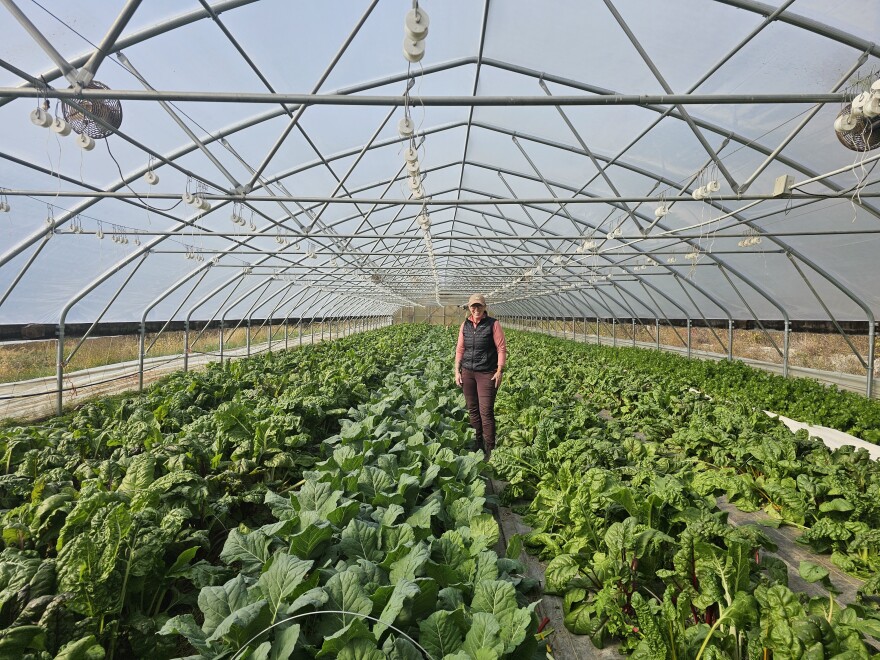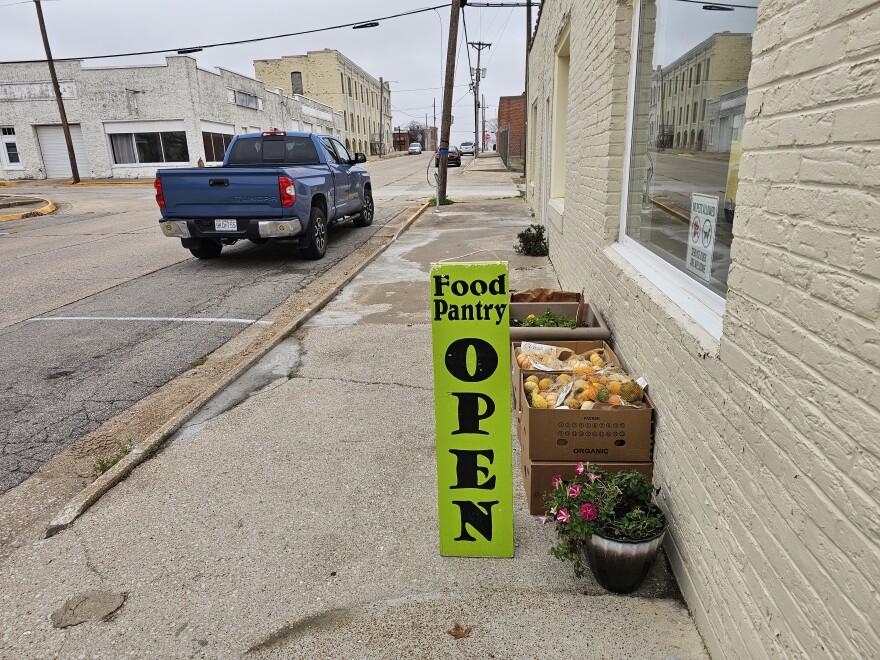It’s Thanksgiving week, and inside the Louisiana Food Pantry in northeast Missouri, people line up for holiday food baskets, including a free turkey.
Jeanne Carnes has been coming to the pantry for about a year, ever since grocery prices climbed beyond what she could manage. In this town of about 3,000, the pantry has become her only reliable source of food. Most days she leaves with bread, beans, milk and canned vegetables — and, when she’s lucky, a few fresh items.
Carnes, who is diabetic, says the pantry became especially important over the summer because it offered a steady supply of fresh produce.
“Through the summer they had lots of fruits and vegetables that were fresh,” she said. “It just makes buying groceries more affordable when you go to the store.”
As a single person, Carnes says she can manage with canned goods and whatever produce is on the shelves. But she’s hoping next summer will bring more fresh options.
“I’m hoping our local growers will still donate their extra produce,” she said. “A lot of it has imperfections that stores won’t take, but it’s perfectly fine to eat.”
The Local Food Purchase Assistance Cooperative Agreement, a federally funded program that helped bring fresh, locally grown food to low-income communities. The initiative, funded by the U.S. Department of Agriculture, paid producers for fruits, vegetables and proteins that were then distributed at no cost to families in need — a program eliminated in March amid federal spending cuts.
In Missouri, the program was managed by the Department of Social Services (DSS) beginning in 2023. DSS partnered with 20 community organizations statewide to distribute food through pantries, churches, food trucks and drive-through locations. According to the department, those partnerships delivered more than $12.3 million worth of food in two years.

Each food box typically included up to $40 worth of produce including seasonal vegetables, fruit, eggs, chicken or pork, honey and cheese. Advocates say the variety and quality were unusual for free food programs.
Crystal FitzSimons, president of the Food Research and Action Center, said the program stood out among hunger-relief efforts.
“This program took a creative approach to supporting health and nutrition,” FitzSimons said. “Traditional food banks work very hard to try and provide the healthiest food possible. But the additional support was really important because it allowed them to really provide local foods in a way that they weren't able to do before those funds were available.”
Most partnerships made their final deliveries in September using previously approved funds. KBIA spoke with people across the state who relied on the program and are now confronting the fallout—from small businesses losing major revenue streams to elderly residents losing access to fresh food. Many described the program as a rare federal effort that supported both rural producers and low-income families.
Local businesses take a hit
Root Cellar, a Columbia-based food hub that aggregates produce from Missouri farmers and sells through a retail store and subscription boxes, is among the businesses affected by the loss of LFPA funding. The company, founded in 2011 by Chelsea Davis, became an LFPA vendor in since the beginning of this program. Now, Davis is closing the business, citing the program’s cancellation as one of several contributing factors.
“The program increased our business three to four times,” she said. “We were able to hire more people and we made a lot of infrastructure upgrades, including buying larger trucks. It was a huge benefit for us as a company.”
Root Cellar served 24 counties in central and northeast Missouri through two partner organizations. Davis sourced produce from farmers within a 250-mile radius and delivered weekly to distribution sites.
“The program was incredibly popular,” she said. “A lot of times when we would show up, there would already be lines of cars waiting to get these food boxes.”
Informing farmers and families that the program was ending, she said, “was heartbreaking.”
Farmers feel the blow
One of those farmers is Liz Graznak of Happy Hollow Farm in Jamestown, who supplied multiple LFPA partners. Expecting continued demand, she expanded production, including up to 1.5 acres of winter squash. When she learned in April that the program would end, she reduced that by two-thirds.

“It was like somebody punched me in the gut,” Grizneck said. “My farm had come to depend on the sales of that produce significantly. It was a quarter of my annual sales in 2024. That’s a huge amount of money for a very small farm like this.”
Since 2023, Graznak said her farm delivered $10,000 to $12,000 in produce each week—and sometimes up to $20,000—to Springfield during peak months, with additional weekly shipments to Kansas worth $1,000 to $2,000.
During a visit this fall, several farmworkers were tending her fields. Graznak said she had to lay off three employees hired to expand production; they have since returned to Mexico.
She said funding cuts worsen already precarious conditions for small-scale produce growers, who lack access to crop insurance and other federal safety nets available to large commercial farms.
“Most people think that food should be cheap, but we can't survive selling cheap food,” she said. “In the 15 years I’ve been farming, many farmers who started around the same time have quit.”
Rural families lose healthy options
The USDA estimated the LFPA program served at least 300,000 Missourians at more than 250 sites—many in rural areas where residents must drive 15 miles or more to reach a grocery store.
Jen Black, executive director of The Alliance Together for Better Communities in Joplin, distributed about 115,000 pounds of fresh food across eight southwest Missouri counties throughout the entire time of the program. Her organization purchased from 62 farmers and outfitted a truck to deliver produce directly to isolated communities.
Black said the program benefited low-income families, as well as refugees, older adults and survivors in women’s shelters.
“People will go hungry at some level, especially kids whose parents are going to rely heavily on school districts to feed them,” she said. “There’s going to be a big impact on multiple systems in our communities as the insecurity grows.”
Although the federal government still funds several food-assistance programs, advocates say little momentum exists to expand them. Earlier this year, lawmakers also cut $186 billion from the Supplemental Nutrition Assistance Program.
“Our current administration has talked a lot about making America healthy again,” FitzSimons said. “We need the message to be consistent with the action. And that includes creative programs that support the purchase of local foods and improve the nutrition quality of meals at schools and food banks.”

